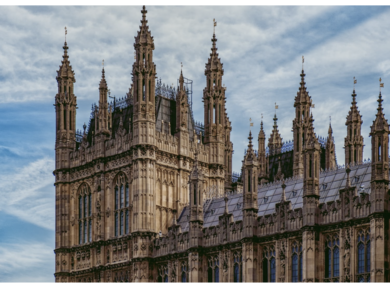Disclaimer: This post reflects solely the opinion of the authors and should not be taken to represent the general views of IPPR’s management/ editorial team or those of fellow authors
In an effort to meet ambitious net-zero emissions targets and respond to an increasingly climate-aware citizenry, governments in the UK and Europe are employing an innovative strategy to formulate climate policy: citizens’ assemblies. These assemblies bring together a group of randomly selected citizens to learn about key climate-related issues, deliberate, form opinions, and put forward their informed policy recommendations. This blog post looks at why governments are increasingly employing citizens assemblies to shape their climate policy agenda and what lessons we can learn from these efforts.
Why Use Citizens’ Assemblies to Address Climate Change?
Scholars and policymakers have often described climate change as the quintessential “wicked problem,” characterized by its complex relationship to other policy areas (like public finance, energy, and labor) and lack of consensus on a single, “best” solution. In addition to the issue’s complexity, polarization and the influence of lobbying groups have hindered governments’ ability to decisively address climate change.
In response to the limitations of electoral politics, activists and researchers have proposed citizens’ assemblies as an alternative. The insulation of citizens’ assemblies from the electoral political process may be an advantage in addressing the climate crisis. Unlike elected legislators, citizens’ assembly participants are accountable to neither a political party nor a constituency, do not face pressure to seek re-election, and are unlikely targets for lobbying groups. This independence results in proposed solutions that are often bolder than what elected legislators may feel comfortable putting forward. Relatedly, citizens’ assemblies intentionally foster a high quality of deliberation. Researchers have found that participants can have more nuanced and open-minded discussions than parliamentarians on the same issues. Thus, citizens’ assemblies allow participants to engage deeply with their peers and a wide range of information on climate change, forming opinions unencumbered by external political pressures.
What Have We Learned About Climate Assemblies So Far?
While many governments and municipalities seem convinced that citizens’ assemblies are a promising tool to shape climate policy, there is still considerable variation in the specific features of these assemblies. Researchers and the organizations that convene citizens’ assemblies are still determining best practices for climate assemblies. However, the recent wave of citizens’ assemblies on climate has already yielded a few key lessons on what these assemblies should look like moving forward:
1. Ideological diversity matters. Citizens’ assemblies on all topics, not just climate change, typically select for descriptive representation, reflecting the population’s gender breakdown and a range of ages, ethnicities, and occupations. However, citizens’ assemblies on potentially divisive issues like climate change should also control for diversity of opinion. Several recent assemblies, including Scotland’s Climate Assembly and Climate Assembly UK, selected participants who represent the diversity of opinion on climate change, not just of the population’s demographic and geographic diversity. In the Scottish assembly, most members entered the assembly believing that climate change is “an immediate and urgent problem” and approximately one-third were unsure or skeptical, consistent with population-level estimates. Ensuring a diversity of opinion may help build legitimacy for a citizens’ assembly, both with elected legislatures and with the broader public.
2. Hybrid assemblies are a promising new model, but further research is needed. The beginning of the COVID-19 pandemic in early 2020 disrupted several citizens’ assemblies, forcing them to move online. Making this switch was not straightforward: there are significant concerns about equity, access to technology, digital literacy, and maintaining a high standard of deliberation and facilitation. A survey of participants in the Climate Assembly UK, which was moved online in March 2020, found that members were nearly evenly-split on a preference for all in-person or hybrid sessions. It’s important to recognize that a purely virtual option was unpopular with the surveyed participants, who described a higher perceived quality of deliberation at in-person meetings. Ultimately, more research is needed to better understand the trade-offs of virtual and hybrid assemblies.
Climate Assembly UK members on Zoom. Source: Involve.
3. For now, citizens’ assemblies are a supplement to elected government, not a replacement. As the use of citizens’ assemblies continues to grow, it is important to remember that they currently serve to furnish elected governments with informed policy recommendations, not to supplant them. Theoretically, this doesn’t have to be the case: proponents of deliberative democracy have called to replace parliamentary second chambers with citizens’ assemblies or for their recommendations to be binding.
However, it seems unlikely that citizens’ assemblies will replace elected government anytime soon, and it’s unclear if this would be a desirable outcome at all. Recently (and perhaps ironically), the Citizens’ Assembly on Democracy in the UK resolved that deliberative processes should be advisory rather than binding, suggesting that public opinion is unlikely to favor climate assemblies with binding legislative power.
That said, elected government itself remains the more immediate impediment. This dynamic played out with France’s climate assembly, the Citizens’ Convention on the Climate (CCC). Unlike similar citizens’ assemblies in the UK, the CCC was nominally granted significant power, with President Emmanuel Macron stating that its proposals would be “unfiltered,” suggesting a stronger role than merely advising government. However, this seemed to backfire. The CCC has been accused of undermining parliamentary authority, and many of its proposals have been rejected or watered down. The lesson from the French case seems to be that securing buy-in from the legislature is central to a citizens’ assembly’s success and that an adversarial relationship with parliament may weaken an assembly.
What’s Next for Citizens’ Assemblies on Climate Change?
Citizens’ assemblies on climate change are only growing more popular. Since the UK Parliament declared a climate emergency, 17 local authorities have held citizens’ assemblies and citizens’ juries on climate change, suggesting that local government may be a crucial battleground for establishing ambitious climate policy. National governments are also taking note of the successes of recent climate assemblies: Spain is one of the latest countries to experiment with a citizens’ assembly on climate which completed its final session earlier this month. Ultimately, citizens’ assemblies are still in an experimental phase. However, the initial results are promising, suggesting that democratic innovation may be an important tool to address the climate emergency.
By Nina Kambili,
Nina Kambili is an MSc Democracy and Comparative Politics student at UCL. Her research focuses on the relationship between new instruments of deliberative democracy and existing representative institutions.







